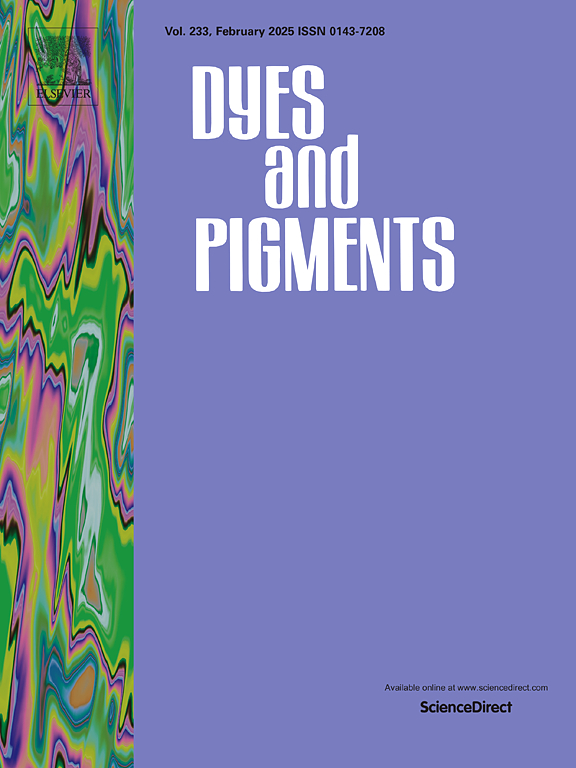用于oled的多功能咔唑和二苯并呋喃基材料:发射体和异构体形成系统
IF 4.1
3区 工程技术
Q2 CHEMISTRY, APPLIED
引用次数: 0
摘要
近几十年来,有机发光二极管(oled)以其独特的优势引起了人们的广泛关注。虽然它们已经集成到许多商业产品中,但与稳定性和效率相关的持续挑战促使我们开发了两种新的多功能化合物,BeCzMFI和BbCzMFI。这些化合物以甲氧基二苯并呋喃-咔唑供电子核为基础,带有额外的脂肪链以增强成膜性能。它们具有优异的热稳定性和形态稳定性,以及良好的光物理性能,使其成为OLED应用的有希望的候选者。这些材料既可以作为发射体也可以作为宿主材料,既可以作为独立的宿主,也可以与受体材料(CN-T2T)结合时作为复合宿主系统的组成部分。我们研究了它们在蓝色和红色oled中的性能,发现外络合物的形成增强了载流子平衡和能量转移效率。使用BeCzMFI和BbCzMFI作为发射器的蓝色器件表现出有效的激子捕获和载流子平衡,导致高亮度,外部量子效率(EQE)为10.4%。与此同时,采用这些材料作为杂化主体的红色磷光oled的最大亮度超过30,000 cd/m2, EQE达到13.6%。这些结果突出了这些多功能材料在提高OLED性能方面的潜力,通过实现传统的和基于异构体的发射机制。本文章由计算机程序翻译,如有差异,请以英文原文为准。
Versatile carbazole and dibenzofuran-based materials for OLEDs: Emitters and exciplex-forming systems
Organic light-emitting diodes (OLEDs) have attracted significant attention in recent decades due to their exceptional advantages. While they are already integrated into numerous commercial products, ongoing challenges related to stability and efficiency have motivated us to develop two new multifunctional compounds, BeCzMFI and BbCzMFI. These compounds are based on a methoxydibenzofuran-carbazole electron-donating core with additional aliphatic chains to enhance film-forming properties. They exhibit excellent thermal and morphological stability, along with favorable photophysical properties, making them promising candidates for OLED applications. These materials can function as both emitters and host materials, either as standalone hosts or as components of exciplex host systems when combined with an acceptor material (CN-T2T). We investigated their performance in blue and red OLEDs, finding that exciplex formation enhances carrier balance and energy transfer efficiency. The blue devices using BeCzMFI and BbCzMFI as emitters exhibited efficient exciton harvesting and carrier balance, leading to high luminance with an external quantum efficiency (EQE) of 10.4 %. Meanwhile, red phosphorescent OLEDs incorporating these materials as exciplex hosts achieved a maximum luminance exceeding 30,000 cd/m2 and an EQE of 13.6 %. These results highlight the potential of these multi-function materials in advancing OLED performance by enabling both conventional and exciplex-based emission mechanisms.
求助全文
通过发布文献求助,成功后即可免费获取论文全文。
去求助
来源期刊

Dyes and Pigments
工程技术-材料科学:纺织
CiteScore
8.20
自引率
13.30%
发文量
933
审稿时长
33 days
期刊介绍:
Dyes and Pigments covers the scientific and technical aspects of the chemistry and physics of dyes, pigments and their intermediates. Emphasis is placed on the properties of the colouring matters themselves rather than on their applications or the system in which they may be applied.
Thus the journal accepts research and review papers on the synthesis of dyes, pigments and intermediates, their physical or chemical properties, e.g. spectroscopic, surface, solution or solid state characteristics, the physical aspects of their preparation, e.g. precipitation, nucleation and growth, crystal formation, liquid crystalline characteristics, their photochemical, ecological or biological properties and the relationship between colour and chemical constitution. However, papers are considered which deal with the more fundamental aspects of colourant application and of the interactions of colourants with substrates or media.
The journal will interest a wide variety of workers in a range of disciplines whose work involves dyes, pigments and their intermediates, and provides a platform for investigators with common interests but diverse fields of activity such as cosmetics, reprographics, dye and pigment synthesis, medical research, polymers, etc.
 求助内容:
求助内容: 应助结果提醒方式:
应助结果提醒方式:


